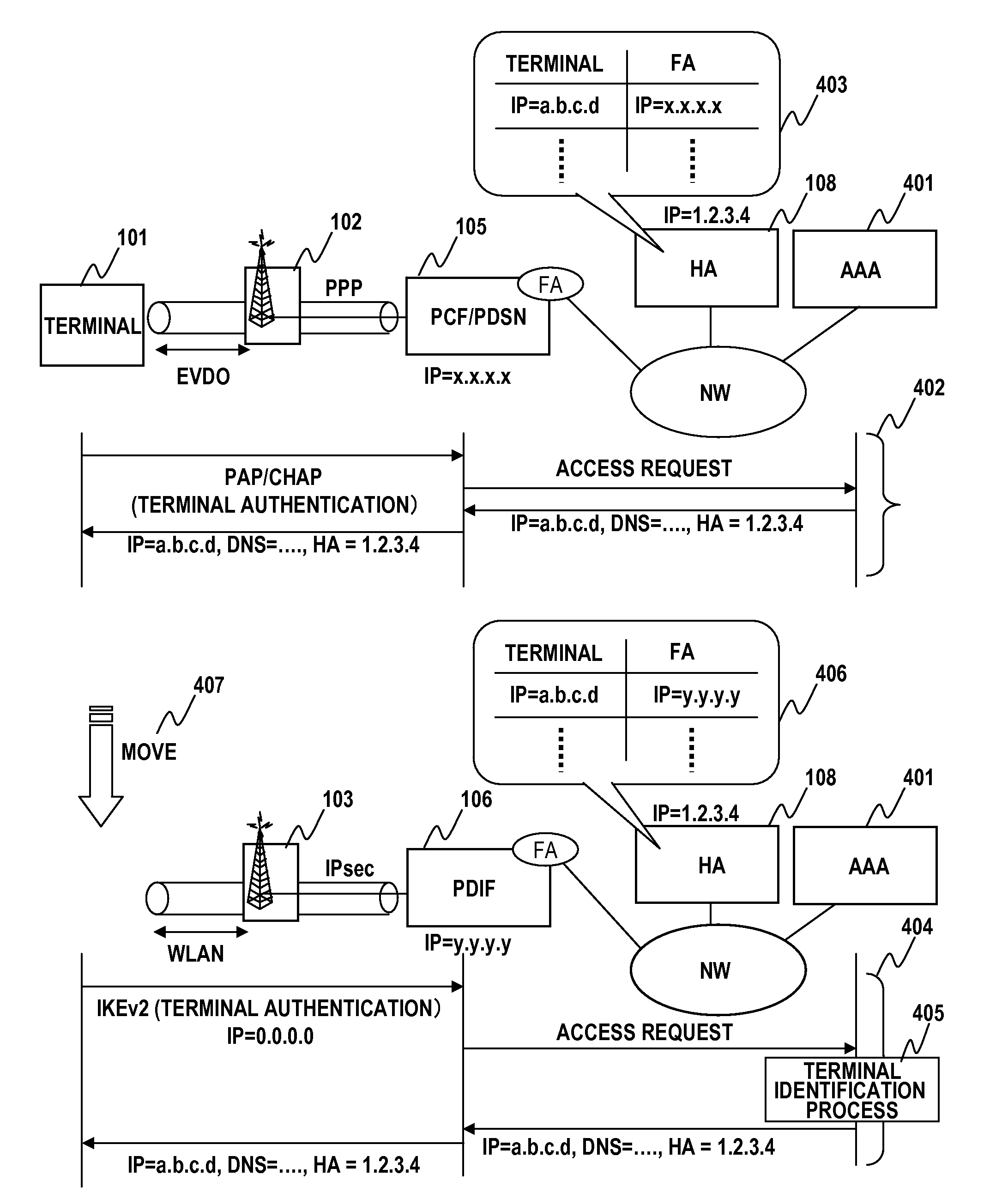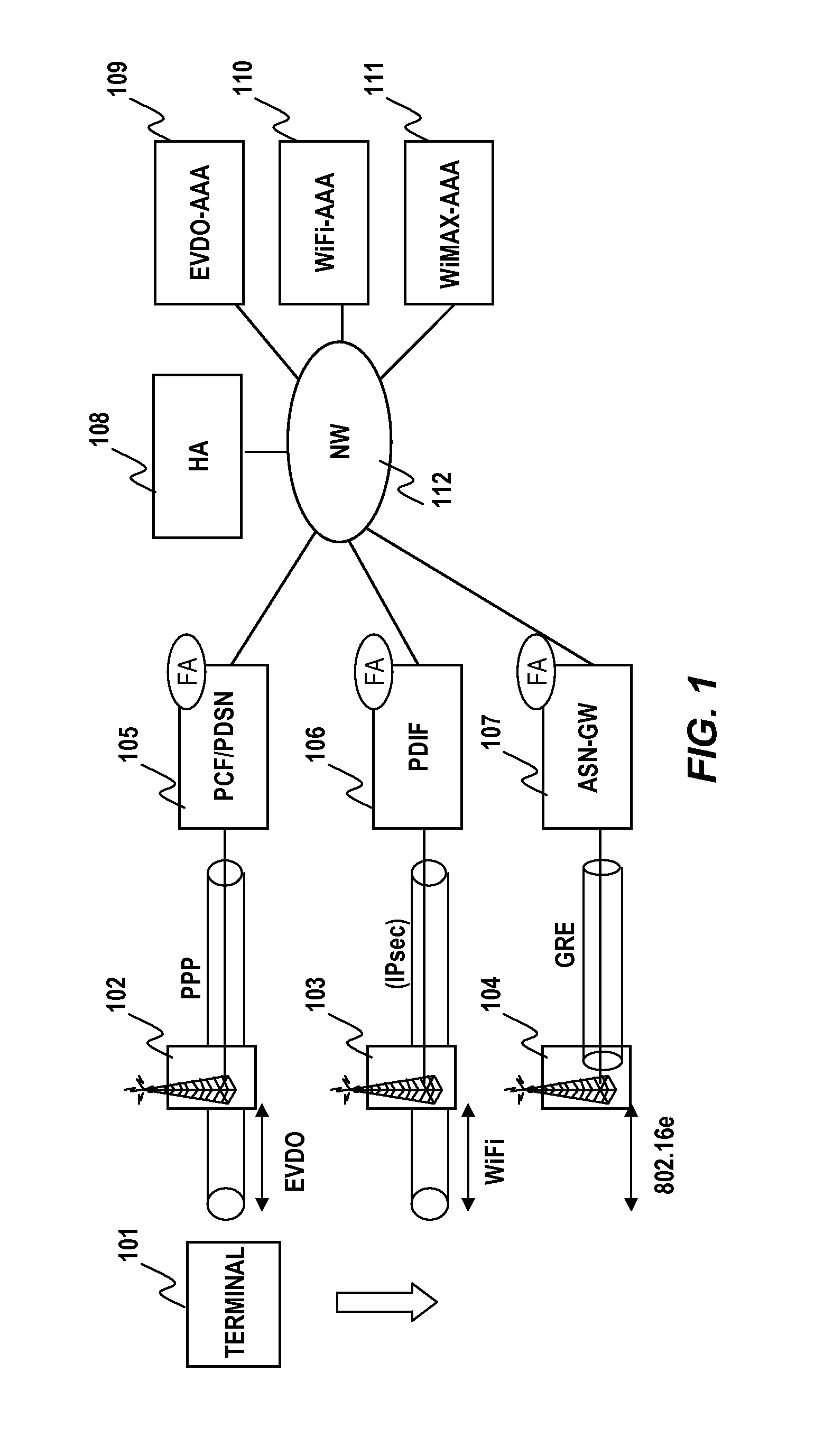Communication system using multi-radio mode, monitor node apparatus, control node apparatus and base station apparatus
- Summary
- Abstract
- Description
- Claims
- Application Information
AI Technical Summary
Benefits of technology
Problems solved by technology
Method used
Image
Examples
first embodiment
[0049]A first embodiment of this invention is described.
[0050]In the first embodiment, as shown in FIG. 4, each of the plural radio systems does not have its own AAA but has a common AAA 401 for the plural radio systems.
[0051]A process of assigning a same IP address to a terminal currently communicating while switching between different systems is described with reference to FIG. 4.
[0052]In a case where a terminal 101 is connected to an EVDO system, terminal authentication using PAP / CHAP is performed between the terminal 101 and PDSN 105 which is an EVDO gateway as shown in a connection procedure 402. Upon completion of the terminal authentication performed by PDSN 105, an access request from the terminal 101 is transmitted to the common AAA 401.
[0053]As a response to the request, the common AAA 401 transmits information such as an IP address (IP=a.b.c.d) to be assigned to the terminal, DNS information and an IP address (IP=1.2.3.4) of an HA to PDSN 105. The IP address is assigned t...
second embodiment
[0059]Next, a second embodiment of this invention is described.
[0060]In the second embodiment, as shown in FIG. 5, a common AAA 401 is also shared by plural radio systems as above-described in the first embodiment.
[0061]A process of assigning a same IP address to a terminal which is currently communicating while switching between different systems according to the second embodiment is described with reference to FIG. 5.
[0062]In a case where terminal authentication using PAP / CHAP is performed between the terminal 101 and PDSN 105 which is an EVDO gateway as shown in a connection procedure 402. Upon completion of the terminal authentication performed by PDSN 105, an access request from a terminal 101 is transmitted to the common AAA 401.
[0063]As a response to the request, the common AAA 401 transmits information such as an IP address (IP=a.b.c.d) to be assigned to the terminal, DNS information and an IP address (IP=1.2.3.4) of an HA to PDSN 105. The IP address is assigned to the termi...
third embodiment
[0071]Next, a third embodiment of this invention is described.
[0072]The third embodiment is an embodiment which is the combination of the first and the second embodiments described above. The third embodiment differs from the first and the second embodiments in authentication parameters included in a connection request transmitted from a terminal, and terminal identification / comparison process performed by a common AAA based on the difference in the authentication parameters. Accordingly, if the common AAA is capable of performing the both, the both systems can be combined.
[0073]FIG. 6 shows a flow chart for the common AAA according to the third embodiment. In both systems, in a case where an access request is received, the request is judged whether the request is from the same terminal by using an identifier unique to the terminal (602). The IP address included in the connection request as a parameter transmitted from the terminal is then checked and an IP address is assigned to th...
PUM
 Login to View More
Login to View More Abstract
Description
Claims
Application Information
 Login to View More
Login to View More - R&D
- Intellectual Property
- Life Sciences
- Materials
- Tech Scout
- Unparalleled Data Quality
- Higher Quality Content
- 60% Fewer Hallucinations
Browse by: Latest US Patents, China's latest patents, Technical Efficacy Thesaurus, Application Domain, Technology Topic, Popular Technical Reports.
© 2025 PatSnap. All rights reserved.Legal|Privacy policy|Modern Slavery Act Transparency Statement|Sitemap|About US| Contact US: help@patsnap.com



